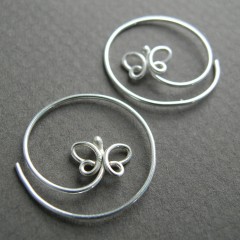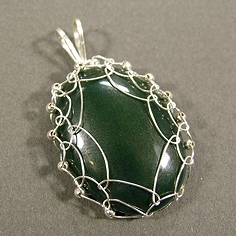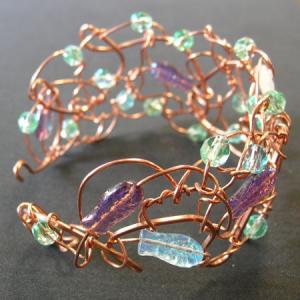
For at least a decade now there has been a very concerted effort to bring wirework into the mainstream consciousness. Many people have dedicated a lot of time and effort to raising the profile of wire – and specifically solderless wire – as a legitimate medium for fine craft.
Thanks to the efforts of these people, and the influence of the Internet, wire artists have been able to show their work, and to connect with each other to share their passion for this form of metalworking.
In recent months I’ve noticed a change in attitude even amongst seasoned metalsmiths. Where previously wirework was written off as not worthy of consideration, I’m seeing it given more prominence. For example, The Metal Arts Guild of Canada – the Canadian equivalent of SNAG – is currently featuring the work of Sarah Williamson on the front page of its website*. Sarah incorporates a lot of Rainbow Wrapping into her pieces. In MAGC’s recent exhibition, not only my work, but also the wirework of Tamara Kronis, Lissa Brunet and Gillian Batcher figured prominently.
I see genuine interest light up in the eyes of people who ask me what I do, instead of watching them turning away and copping an attitude of “Oh… you don’t make “real” jewellery.”
Unlike 10 years ago, information on making wire jewellery is easy to find.
All of these developments are very positive.
Anyone who has followed this blog for any length of time knows that I am committed to producing quality work. Anyone who has taken a class with me, or who has bought one of my tutorials knows that my commitment to quality also extends to my teaching. One of the most treasured compliments I’ve ever gotten came from a Professor at George Brown College who taught the full-time jewellery program’s first year courses. She greeted me one day while I was setting up for my class, and said that she had “heard good things” about my course. I’m very proud of the fact that several people who took my class enjoyed it so much that they went on the enroll in a full-time jewellery program. It’s equally gratifying that students from the program have joined my class and showed openness to this alternative form of jewelry making.
So… it drives me crazy when I see self-styled “instructors” churning out tutorials that teach bad technique. Worse still is when I see a publication which positions itself as an industry leader allowing bad technique to be showcased without making the slightest effort to ensure a reasonable quality of workmanship. It makes me want to bang my head in utter frustration.
I happened to pass by a local newsstand yesterday, and decided to stop in to see if any of the magazines I regularly peruse were in. I flipped through the latest issue of Step-by-Step Wire Jewelry. SbSWJ is the only magazine since the demise of The Wire Artist Jeweller to devote itself exclusively to wirework. In all honesty, it can only be regarded as the poor cousin of the latter. Certainly, the projects are more simplistic – most are geared towards beginners – but to some extent I can understand that. There is a limit to the number of steps that can be included to make each project when you’re showcasing 10+ designs an issue.
One of the projects was a neckpiece, attractive enough and easy to make. It used square wire, also not a problem. Here’s what made my jaw drop: the right half of the necklace was riddled with components where the wire had gone “off square“. What that means is that the artist did not have control of her wire.
Square wire bent around something curved like round nose pliers or a ring mandrel has a tendency to want to turn on its edge. As a result, what you see is the corner of the wire rather than the smooth surface. Maintaining control of the wire is vital for ensuring that the finished product looks nice, otherwise you’ve wasted your effort. Any artist that cannot control their wire has no business trying to teach others. It’s a waste of the students’ time.
There are a bunch of issues I see here:
First, by allowing the photo of this project with its poor workmanship to be published, SbSWJ is telling the wire community that not paying attention to the details is okay. IT’S NOT OKAY. Historically, it’s the lack of attention to detail that has caused the greater metalsmithing community to dismiss wirework. Publishing crappy workmanship undermines the efforts of all of the people trying to educate the public and raise the profile of the craft. This is a huge deal to the people who do wirework professionally.
Some might argue that they’re not interested in doing it professionally, that they are only interested in making it for themselves or as gifts for friends and family. Okay fine. Learning to make a piece well makes it that much more special and treasured. It’s worth the effort. The magazine still has a responsibility to provide the best visuals and instructions for accomplishing that goal.
Some might argue that the magazine can only work with what they’re sent.
To this I say: BULLSH*T
I’m the editor of a magazine that publishes three issues a year. Yes, it is difficult to deal with images that are poor quality. But here’s the thing: when SbSWJ published my Ladder Pendant project in March 2005, they asked me to reshoot some of the images, because the quality wasn’t good enough for print. It is up to the magazine to set the bar and that includes setting the bar for the editorial content. A magazine that purports to teach should at the very least START with insisting on proper technique. Anything less does not service the readership, and people will stop buying the magazine. Wire control is one of the fundamental techniques and SbSWJ is failing in their mandate. Subscribers should be writing to the magazine and DEMANDING better.
As an artist, it’s a huge deal to be published. It’s a fabulous achievement. I still remember the high I felt being published in a major magazine for the first time. Your work is out there, getting attention, filed in the Library of Congress, available for people to read about 5, 10, 25, 50 years from now. So.. why would you submit something that is less than absolutely perfect? Is this really how you want posterity to see you?
As an instructor, if you can show that your workmanship is of the highest quality, being published is a stellar marketing tool. Your tutorials will be in demand. You’ll have repeat customers. You’ll make more money. It’s not just about making money though, it’s about mentoring. People just starting out want the best information available. They want to do well, and it is the instructor’s responsibility to help them take the baby steps that builds their confidence in their abilities. Not everyone will be able to make a virtuoso piece, but if the instructor’s work is not much better than the beginner’s first efforts, there is no chance at all for the student to develop the necessary skills to even make the attempt.
Step by Step Wire Jewelry, in its writers guidelines, states that their readers are “active amateurs and practicing professionals”. By publishing workmanship that is blatantly unprofessional, they are not doing themselves, their contributing artists or their readers any favours; in fact, they are actively damaging the larger wire jewellery community. They have an opportunity to take a leadership role in fostering best practices for quality. There is no excuse for not taking it.
* Disclosure: I am currently a member of the MAGC Board of Directors, but I do not participate in choosing who gets featured on the front page of the website.






